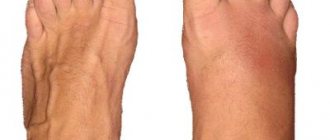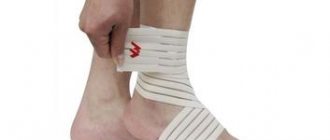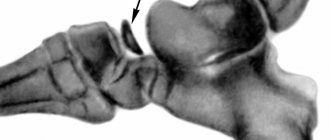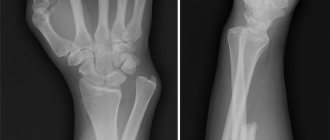Author of the article: Eduard Svitich - orthopedic traumatologist
Fractures of the 5th metatarsal bone are a fairly common injury, the treatment of which has many nuances. Incorrect treatment of damage to a seemingly small bone sometimes leads to serious disorders. Sometimes, when there is an obvious need to fix the fracture, for some reason this is not done, but sometimes the situation is the opposite: when it is possible to prescribe a light orthosis, the foot is unreasonably shackled in a heavy, pressing plaster.
The orthoses presented at Medtekhnika Orthosalon meet all the requirements of a proper fixator: they are lightweight, anatomical, breathable and comfortable. Such devices provide the expected positive effect both during conservative treatment of injury and in the postoperative period. We will discuss in more detail below what types of metatarsal fractures there are, how to suspect them and how best to treat them.
Types of fractures
The metatarsal bones are the part of the skeleton that forms the “foundation” of the toes. It is with the head of the metatarsal bone that the phalanx of the finger is connected. The 5th metatarsal bone is located on the outer edge of the foot, its bony protrusion - the styloid process - is quite easy to feel under the skin. This bone has several features:
- The head of the 5th metatarsal bone is one of the three fulcrum points of the foot. When you walk, at least a third of your body weight presses on this tiny area.
- The short peroneal muscle and a strong ligament are attached to the base, or more precisely, the styloid process of the bone. When the foot deviates inwards, these structures become tense and pull the metatarsal bone along with them.
After injury or overload, the head, diaphysis (body) or base of the bone may break. Due to a number of features, a fracture most often occurs at the base of the bone - its widest part. In this case, the most typical are two types of injury:
- Jones' fracture or dancer's fracture is a typical base fracture, more unfavorable due to poor blood circulation in this area;
- fracture of the styloid process - separation of a small section of bone, more favorable due to good blood circulation and low load.
Causes of injury
Fractures of the base of the 5th metatarsal bone can be traumatic and stress-related.
A traumatic fracture is a consequence of a simultaneous overload of a bone during a fall, jump, or twisting of the foot. In an avulsion fracture, the styloid process is torn off by the pull of a powerful tendon and ligament. The diaphysis of the bone can break when a heavy object falls on it or a loss of balance occurs during excessive load on the outer edge of the foot.
Interestingly, the so-called dancer's fracture was first described by the English traumatologist Jones back in 1902. The doctor received the injury while dancing and at first believed that he had damaged a ligament or tendon. After taking an x-ray, he discovered that there was a fracture at the base of the 5th metatarsal. The doctor described all this in an article for a medical journal, after which the injury was named after Jones.
A stress fracture is a consequence of overload of the musculoskeletal system. In this case, microdamages accumulate, and a “crack” forms gradually. This type of injury is typical for athletes, manual workers, and military personnel. Sometimes the condition goes unnoticed, and its consequences are revealed during examination for a completely different reason.
Rehabilitation
The speed of recovery after a fracture of the metatarsal bone of the foot depends on various factors:
- severity of injury;
- age of the patient;
- accompanying pathologies.
For example, in patients with diabetes, as well as in older people, tissue regeneration slows down significantly. A history of osteoporosis requires special attention and intensive therapy.
The rehabilitation period includes a set of procedures, the goals of which are to completely restore the functionality of the foot and return the patient to a working condition. For this purpose they prescribe:
- physiotherapy;
- massage;
- a set of therapeutic exercises.
A metatarsal foot fracture will heal faster if the patient undergoes a full course of physical therapy. The recovery method is prescribed by a doctor and is available at home. It could be:
- magnetic therapy;
- electrophoresis;
- Ural Federal District;
- phonophoresis;
- laser therapy.
Mud baths and paraffin applications are useful. Each of these methods increases blood circulation, improves nutrition and regeneration of damaged tissues.
The massage course is aimed at restoring mobility and strengthening the ligamentous apparatus. Sessions should be conducted by a qualified specialist who has the technique of therapeutic massage.
Therapeutic exercises are prescribed after removing the plaster cast. The list of exercises and their frequency are prescribed by the doctor together with the physiotherapist. The first classes are conducted under the guidance of an instructor who teaches the correct technique and teaches how to dose the load. In the future, it is recommended to regularly perform therapeutic exercises at home.
A set of basic exercises:
- Flexion and extension of the toes on the injured leg.
- Sitting on a chair, perform heel-to-toe rolls.
- Bend your foot, stretching the front part of it forward and back, in the opposite direction. In this case, a noticeable tension should be felt.
- Rotate the foot to the left and right.
- Rolling a massage roller, a small ball or a bottle filled with water on the floor.
- Rotate the foot in a circle in different directions.
- Exercise "scissors" in a lying position - crossing slightly raised legs.
Each movement should be performed slowly and smoothly. In this case, the patient should not experience pain. If pain occurs, exercise should be stopped and your doctor informed.
If you follow all the specialist’s recommendations, it will take from 1.5 to 3 months to restore your ability to work. In most cases, the prognosis is favorable. Impaired functionality may be a consequence of delay in contacting a doctor and attempts at self-medication.
Symptoms of a 5th metatarsal fracture
At the moment of fracture, you can hear a crunch and feel a sharp pain. The foot may swell greatly; less often, swelling and pain are located only in the projection of the base of the bone. Stepping on, moving or touching your foot also hurts. Without an x-ray, it can be difficult to distinguish such an injury from a banal ligament tear or a serious bruise.
The symptoms of a stress fracture are often vague. Aching pain and slight swelling along the outer edge of the foot may bother you. When bone strength is reduced to a minimum, a complete fracture may occur with the typical picture of an acute injury: severe pain, swelling, and impaired function of the foot. As in the case of a traumatic fracture, diagnosis cannot be done without radiography.
Treatment Options
The easiest to tolerate is an avulsion fracture of the styloid process. As a rule, the foot is fixed with a plaster cast or a polymer orthopedic boot for a period of 2 to 4 weeks. If the pain syndrome is insignificant and the patient does not engage in heavy physical labor or sports, early exercise in the orthosis is acceptable - walking with support on the injured leg. In athletes, due to increased demands on the condition of the feet, treatment is more strict, sometimes including surgery - osteosynthesis.
Due to poor blood circulation and heavy load when walking, a fracture of the base of the metatarsal bone (Jones fracture) heals extremely poorly. A frequent complication is the formation of a false joint, secondary displacement of fragments. The duration of immobilization varies from 6 to 12 weeks. If during the first month there are no signs of fusion in the orthosis or cast, it is recommended that the fragments be surgically compared with further fixation with a screw, pin or plate.
Prices
| Initial appointment with a traumatologist-orthopedist | 1 600,00 |
| Appointment with a traumatologist-orthopedist after MRI/X-ray in our Center | 1 500,00 |
| Appointment with a traumatologist-otropedist, repeated appointment | 1 300,00 |
| Manipulation | |
| Novocaine blockade | 1 200,00 |
| Intra-articular administration of drugs Without the cost of drugs | 2 500,00 |
| Applying a small plastic bandage | 2 500,00 |
| Application of a medium plastic bandage | 3 500,00 |
| Applying a large plastic bandage | 5 000,00 |
| Removing the bandage | 1 500,00 |
| Reposition of bones, reduction of dislocation | 2 000,00 |
| Removing a tick | 500,00 |
| Removing spokes from outside 1 pc. | 500,00 |
| Local anesthesia | 500,00 |
| PHO with adhesive plaster stitches | 1 200,00 |
| PST of wounds up to 5 cm | 1 200,00 |
| PSO wounds more than 5 cm | 2 500,00 |
| Burn treatment up to 1% | 2 000,00 |
| Treatment of burns greater than 1% | 5 000,00 |
| Dressing wounds up to 5 cm | 800,00 |
| Dressing wounds larger than 5 cm | 1 000,00 |
| Opening a hematoma | 1 500,00 |
| Opening and draining the abscess | 2 000,00 |
| Removal of benign formation | 3 000,00 |
| Cosmetic stitches up to 5 cm | 1 000,00 |
| Cosmetic stitches over 5 cm | 2 500,00 |
| Removing the nail plate | 3 700,00 |
| Removal of foreign bodies | 2 500,00 |
| Diagnostic joint puncture | 2 250,00 |
| Removing spokes from inside 1pc | 2 500,00 |
| Pain relief | 500,00 |
| Para-articular administration of drugs | 1 500,00 |
| Surgery for ingrown toenails | 1 500,00 |
| Taping | 1 300,00 |
| Application of an orthosis, splinting without the cost of consumables | 500,00 |
| Removing stitches | 1 000,00 |
| Intramuscular injection without drug costs | 250,00 |
Show entire table
Orthosis for fracture of the 5th metatarsal bone
For any fractures of the 5th metatarsal bone, it is necessary to immobilize the foot for a certain period of time. Standard plaster casts have a number of disadvantages: they are heavy, moldy, cannot be stepped on, and there is no access to the skin or postoperative wound. Modern polymer ankle orthoses do not have such disadvantages and have clear advantages. They are light, comfortable, easy to remove and reattach, and allow full walking with the doctor's permission.
Most often, short orthopedic boots are prescribed for the treatment of metatarsal bone fractures. These orthoses securely fix the foot and provide complete rest at the fracture site. The presence of a removable plate with straps makes it easy to “open” the orthosis for regular care and monitoring of the skin. The sole of the product has a slightly curved shape to ensure a natural step algorithm in case of full load. You can find such rehabilitation products in Orthosalons in Dnepr, Odessa, Lvov, Kharkov, Kyiv and other cities of Ukraine, where there are stores in our network.
An additional option in such orthoses are pneumatic splints. They are two symmetrical pads located on the sides of the heel and ankle joint. Using a small bulb pump, it is possible to increase or decrease the volume of these splints, changing the degree of fixation and compression of the tissues. In this way, it is possible to achieve the most reliable and comfortable fixation and adapt to increasing or decreasing swelling.
Sometimes the doctor may give preference to a high orthopedic boot - a device that more significantly fixes the ankle joint area. Despite its large dimensions, such an orthosis has only slightly more weight due to its thoughtful design and unique composition of polymer plates. After successful recovery, elastic foot and ankle braces are effective in reducing possible pain and swelling. They prevent tissue swelling, gently massage the tissue and stimulate the function of the foot's stabilizer muscles to prevent re-injury.
Advantages and disadvantages
The doctor will help you choose the appropriate type of retainer.
After removing the orthosis, which has a rigid fixation, bandages made of elastic and durable materials are used. They can be corded, belted, or reinforced with plastic parts. Their advantages are:
- rapid adaptation of the ankle joint to normal functioning;
- increased range of motion of the ankle;
- ensuring comfort and aesthetics;
- Perfect fit to the shape of the foot.
The disadvantages of orthoses include the impossibility of using them immediately after a fracture, and the prohibition of wearing them in bleeding open wounds. The orthosis is recommended for use at the stage of bone tissue fusion. Sometimes allergic reactions occur. The main thing is to choose the right orthosis or bandage and follow all instructions. If you have any questions, contact your doctor.
Prevention
A fracture of the metatarsal bone of the foot can be prevented by following simple rules:
- eat right and lead an active lifestyle;
- monitor your weight and prevent the appearance of extra pounds;
- wear comfortable shoes with heels no higher than 4 cm;
- perform feasible physical exercises to strengthen ligaments and muscles;
- go swimming.
If you suspect a fracture, do not try to cure the injury yourself, but immediately contact a medical facility.











